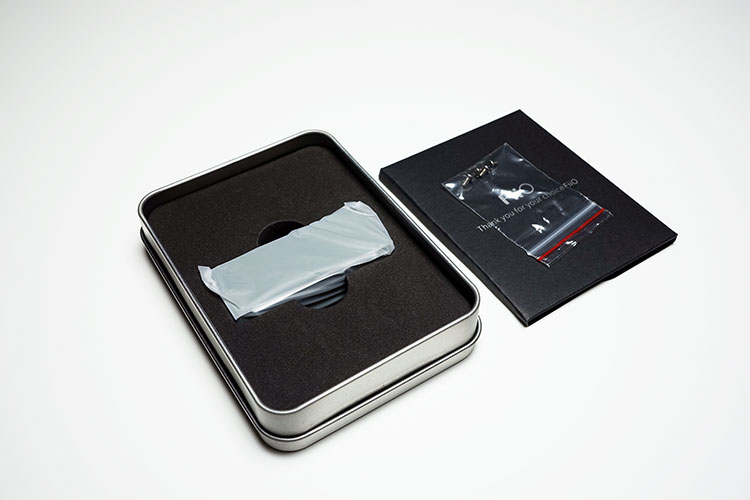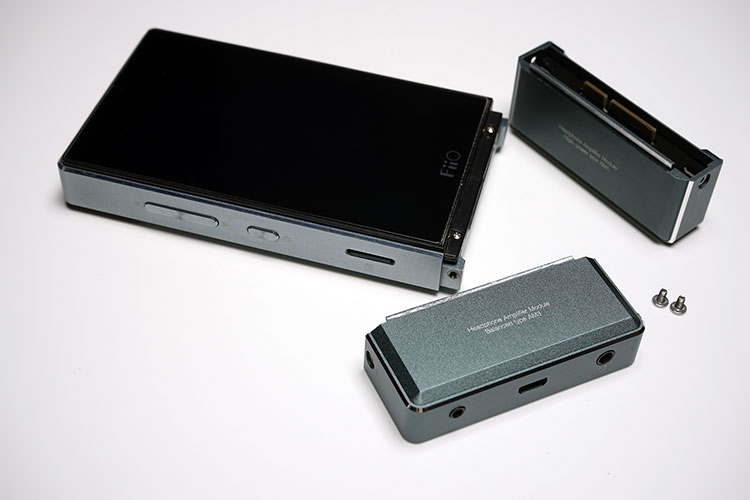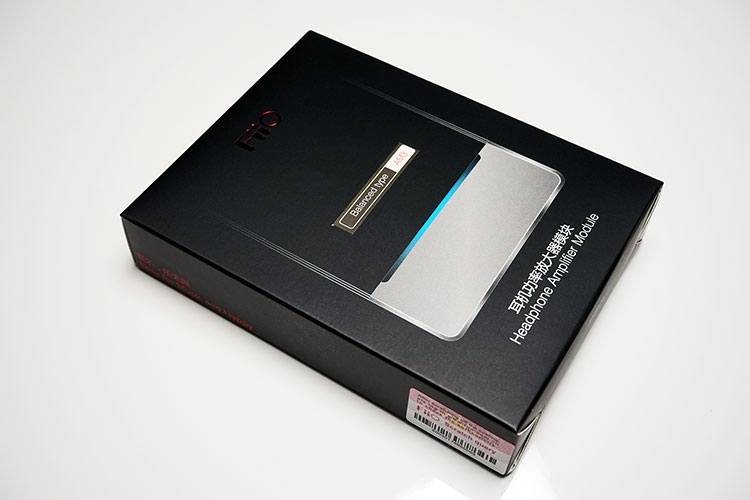The FiiO AM3 is a brand new amplifier card for the X7 DAP series and Q-series portable DAC/AMP featuring balanced outputs. It is priced at $99.
Disclaimer: The FiiO AM3 sent to us is a sample in exchange for our honest opinion. We thank FiiO for this opportunity.
To learn more about FiiO reviews on Headfonics you can click here.
The AM3 amp module for the FiiO X7 DAP is now the 4th module to be released with an amping stage inside and is priced at $99. This is consistent with the previous amping module prices for the AM1, AM2, and AM5 and represents something a little different to the previous 3 modules.
The previous three modules addressed different efficiency and power needs from users with IEMs, portable headphones, and high impedance singled ended full-size headphones. The AM2 and 5 had a highly musical slant to their sound signature and plenty of grunt to handle a wide range of headphones.
I certainly found them more enjoyable than the AM1 and IEM usage was not out of the question with either of these two. However, the AM3 treads a different path and one slightly more specific to audiophiles.
Tech Inside
The AM3 is the first module released by FiiO that has both a single-ended or unbalanced 3.5mm output and a 2.5mm TRSS balanced output side by side.
FiiO is directly pitching the AM3 therefore as having the “best of both” meaning you can go either single or balanced depending on your input jack and do remember FiiO also sell a handily priced line of balance cables for IEMs so there is a definite product association there.
It is also welcoming for FiiO to bring in the concept of a balanced output on the X7 given quite a lot of new DAPs these days from the Cayin N5 to the AK380 have a balanced output capability as standard whereas the X7 does not.
Whilst not being specifically marketed as a high powered amp module the specs certainly would give some credence to the AM3’s balanced output signal being significantly stronger on higher-rated headphones, even on par or better with the AM5 in terms of output power by 1-2dB.
Design
Like all previous modules apart from the original AM1, the AM3 has that same gray metallic finish that is slightly darker in nature to the X7 body. It means you will not get a tonal match. The only module right now that gives you uniformity of color is the AM1. The X7 leather case will take care of any color mismatch and protect the X7 same time so I suggest you grab one.
The module differs from the others by its inclusion of two output jacks with the single-ended 3.5mm on the far left and the balanced 2.5mm output on the far right of the bottom panel. In between both is the USB socket which maintains the same functionality for docking and loading memory as well as for DAC out purposes.
On the back, it states AM3 which is very useful considering all the amps look exactly the same from the top down. You also connect the AM3 amp module in the exact same way as AM1/2 and 5 through the two t5 locking screws, one on either side of the X7. Takes all of about 1 minute to successfully complete a changeover.
TI OPA1622
In order to produce an amp module that can offer both balanced and unbalanced FiiO have elected to stick in no less than 6 TI OPA1622 chips into the AM3. That’s two chips dedicated to the unbalanced output signal and naturally 4 for the balanced output signal.
This is a brand new chip from Texas Instruments and they are pretty hot on it being one of their best yet. The salient feature of this opamp is its ultra-low HF distortion numbers under load, significantly more than the AM2 and AM5 and on paper at least a very good level of noise control (including the dreaded clicks and pops on shutdown mode).
Battery
The OPA1622 is a fairly compact opamp also and ideally, for mobile devices, it is also a low power consumption chip. You will be pleased to know that in balanced mode the rated battery life of the X7/AM3 pairing is still rated at 6 hours which is the same as the single-ended high powered AM5. That is despite having a slightly higher output power rating and an equally powerful voltage output of the AM5.
In real-world usage, I got a little more out of balanced mode without heavy usage of the screen and song selection, almost 7 hours but this dropped to close to 6 with more screen time and high codecs as well as IEMs with higher power demands.
Accessories & Packaging
As with each previous iteration of the amp modules for the X7 you receive a fairly standard small pack with the following accessories:
- Small T5 screwdriver (for changing modules)
- Module chip rubber cover
- One set of spare screws
- Amp module inside a protected metal case (much like the old E11 case)
I can’t really see this change since we just receive the new AM2a module in the office which is the exact same format. Its pretty good value for $99 if you ask me and professionally put together.
Sound Impressions
The AM3 tonally is quite consistent with the smooth and natural-sounding AM2 but whereas the AM2 and more so the AM5 has a more musical gutsier approach with a meatier low end, the AM3 trades this in for slightly more linear bass performance and a sweeter and more refined midrange in unbalanced mode.
Texture and detail on the AM3 are excellent and to my ears a little more accurate in timbre to the AM2. It lacks the aggression of the AM5 though which for some may be a good thing, for others, particularly lovers of hard rock and EDM they may feel the AM3, in unbalanced mode, lacks a little punch.
Switching up to balanced mode and the AM3 suddenly sounds a lot more aggressive and impactful with better body and slam in the lows, better treble extension and sparkle, and a much more vivid and engaging midrange.
There is no loss of detail compared to its unbalanced counterpart and certainly no loss of coherence either even with an enhanced low end. Vocals sound natural and flowing, sibilance is to a minimum also. It is still natural-sounding but far more musical now than the unbalanced output, even more so than the AM5 which sounds just a little soft in the attack in comparison.
Synergy
Balanced v Unbalanced
IEMs
Balanced is more powerful, using a 20Ω Fidue a91 the difference was immediately noticeable with a richer more dynamic presentation, heavier hitting bass response, increased vocal presence.
Volume increased by around 5-10% also, for example, 33-34 steps in unbalanced is around 31-32 steps on balanced mode. Whilst the Fidue is by no means a power-hungry IEM it did sound more optimal with a balanced signal.
Dynamic Headphones
Another good example is my power-hungry old K501, a stellar headphone for midrange but can get sucked out in the highs and lows if inadequately powered. In unbalanced mode volume in high gain was around 85-90 steps.
In balanced mode, I didn’t need to adjust the volume but in came a better treble extension, increased staging width, and fuller bass response. Dynamics came up a few notches also. Clearly, the additional power really benefitted the K501.
Planar Headphones
For efficient planars, such as the He400s and the PM-3, the same trend continued. Not so much of a volume adjust required moving from unbalanced to balanced but instead, the headphone felt better driven, better optimized with both showing off richer dynamics, better snap and slam in the bass delivery, and sharper imaging. In contrast, the unbalanced sounded pretty good just a little flatter but not by much.
I would not recommend grabbing an LCD-2, HD800, or an HE1000 for the AM3 though. Balanced will give you a better drive but it is still nowhere near-optimal. Better to strap a Bakoon HPA-01M amp under your X7 to get satisfactory results.
For those IEMs, dynamic headphones or efficient planars that need the power or can scale with power using the 2.5mm TRSS option is much preferred. Remember balanced doesn’t change the tonality, it just simply gets the can or IEM performing optimally with adequate power.
Select Comparisons
AM1
No question the AM3 is the most powerful of the two modules in balanced and unbalanced mode. However, if you are using highly sensitive IEMs the AM1 will have better micro-volume control and use up less battery power giving you 30% more battery life than the AM3.
Tonally the AM3 in unbalanced mode has a smoother slightly fuller sound than the AM1 with an enhanced but still well-controlled bass response. Dynamics on the AM3 is superior with a much more vivid and engaging presentation. The AM1 sounds more neutral, flatter, and thinner by comparison. The detail and clarity on both are still very good though so there is no loss of resolution by switching from one module to another.
With the AM3 in balanced mode, it is the same tonal switch up as unbalanced just multiplied by 10. In balanced mode, you get a far more vivid and dynamic presentation, increased bass response, wider and deeper staging with much better separation. In balanced mode the AM3 makes the AM1 seem very underpowered and underwhelming in comparison.
AM2
The AM2 stacks up pretty well against the AM3 in unbalanced mode and offers around 2 hours more battery life, but there are some tonal differences. The AM2 has a slightly more dynamic presentation with a gutsier bass response and a touch more slam over the more relaxed and linear sounding bass performance of the AM3.
Both have a warm to neutral presentation but the AM3 has the slightly more laid back feel overall. The AM2 just pushes forward the staging a touch more over the more neutral staging of the AM3.
Instrumental separation is good on both but I would tend to veer with the AM3’s smoother and more enticing timbre for a wider range of classical and jazz-influenced genres with the AM2 performing slightly better on modern rock and pop.
In balanced mode, the AM3 pulls ahead of the AM2 tonally. In comes, a wider and deeper soundstage with enhanced bass depth and slam and better body all round, especially with vocals. If the AM3 is for relaxed genres the balanced mode is for modern pop and EDM. If you have a 2.5mm TRSS the AM3 clearly represents better value than the AM2.
AM5
The AM5 power ratings are very similar to the AM3 in balanced mode actually but the AM3 has superior distortion ratings by around 8dB and offers a more refined presentation on higher powered headphones such as the HE400s and PM-3.
On more efficient IEM’s the AM3 sounds the politer of the two with a more controlled bass response compared to the more aggressive slam of the AM5. The AM5 in unbalanced mode sounds the more dynamic and powerful of the two and definitely more suited to anything that needs that bit of extra oomph and body in bass performance.
In balanced mode with IEMs, the difference is far less noticeable and I give the slight edge to the AM3 which offers a cleaner response, slightly more sparkle in the treble, and a weightier mid-bass presence.
If you don’t have balanced cables then the AM5 is still the top module for me, even with a wide range of IEMs. However, if you do have a few balanced cables around, particularly for inefficient IEM’s the AM3 is the superior choice.
Our Verdict
The AM3 represents the best value amp module to date for the X7 DAP. It has not one but two signature profiles with a smooth sounding and coherent but polite unbalanced mode and a more aggressive, dynamic, and powerful balanced output.
You will hear the difference between the two outputs tonally and in terms of power. If you are sporting say a Fidue A91 go balanced, it is far more rewarding. If you are using a single-ended reasonably efficient IEM then go unbalanced for its refined but detailed approach. It is like two modules for the price of one.
If it is all about pure power, then technically the AM5 will do the business over the unbalanced AM3 output signal. If you have no intention of going balanced, then grab the AM5 for larger headphones with higher power demands. It is still the best unbalanced module in the lineup for that purpose. However, I urge you to consider tooling up on 2.5mm TRSS balanced cables and listen to what the AM3 has to offer.
It will be interesting now to see what new modules come out of the FiiO factory for the X7. With the AM3 I personally think you have all the power-related questions answered with the 4 modules now on offer from IEM super-efficient to reasonably powerful dynamic and planar headphones.
Perhaps the next step will be niche, something more colored and unusual. I certainly hope that this is not the end (there is AM2a out now so no it is not the end) and we keep seeing something come out that gives the X7 a brand new flavor. The modules really help to keep this DAP fresh and interesting.
FiiO AM3 Technical Specifications
| 3.5mm headphone output | |||
| Output Power 1 | >250mW(16Ω/1kHz) | Output Impedance | <0.3 Ω(32Ω load) |
| Output Power 2 | >190 mW(32Ω/1 kHz) | Channel Separation | ≥72dB (A-weighted) |
| Output Power 3 | >25 mW(300Ω/1 kHz) | THD+N | <0.001% (32Ω/1 kHz) |
| Frequency Response | 5 Hz~83 kHz (-3dB) | Peak Output Voltage | >7 Vp-p |
| SNR | ≥115dB (A-weighted) | Max. Output Current | >80 mA(For reference) |
| Drive Ability | 16~150Ω (Recommended) | ||
| 2.5mm TRRS balanced headphone output | |||
| Output Power 1 | >420mW(16Ω/1kHz) | Output Impedance | <0.3 Ω(32Ω load) |
| Output Power 2 | >540mW(32Ω/1kHz) | Channel Separation | >100 dB(32Ω/1 kHz) |
| Output Power 3 | >70mW(300Ω/1kHz) | THD+N | <0.0008% (32Ω/1 kHz) |
| Frequency Response | 5 Hz~83 kHz (-3dB) | Peak Output Voltage | >11 Vp-p |
| SNR | ≥115dB (A-weighted) | Max. Output Current | >160 mA(For reference) |
| Drive Ability | 16~300Ω (Recommended) | ||





